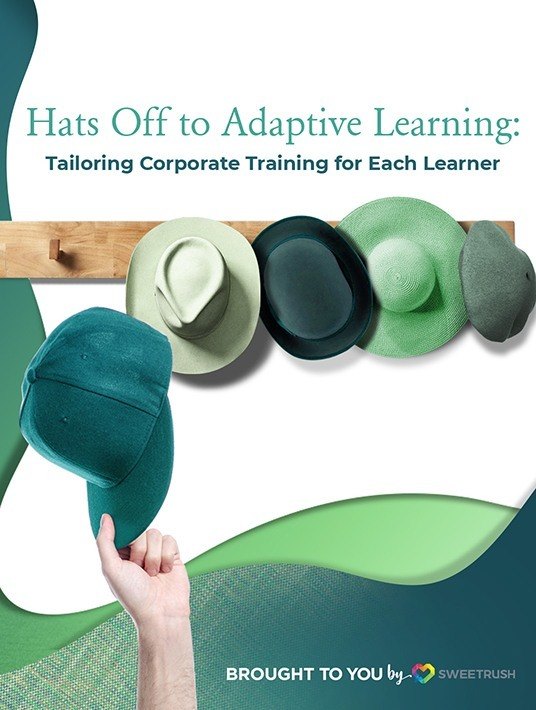Adaptive Learning And Personalized Learning
Just about every community of practice faces a similar conundrum: two terms that some members believe represent different constructs, while others believe are the same. In computer science, there’s "Artificial Intelligence" and "machine learning"; in environmental policy, there’s "global warming" and "climate change"; in cooking, "yams" and "sweet potatoes." Sometimes the distinction is useful, sometimes it’s not.
In Learning and Development, one such difference of opinion exists around the terms "adaptive learning" and "personalized learning" (aka "personalization"). Some suggest they’re separate concepts, while others believe they’re the same.

We’re in the latter camp. It’s our opinion that personalized learning is operationally synonymous with adaptive learning, and from a design standpoint, we haven’t seen the value to date in differentiating the two. To us, "adaptive learning" and "personalized learning" both describe learning design that attempts to tailor instruction to the understanding, skills, and interests of an individual learner, through technology, human intervention, curriculum design, pathway or journey, and most likely some blend of these.
But "personalized learning" has a growing interest in K-12 education, and eLearning vendors have begun appropriating the term, so it’s worth examining what’s been done there, to see what can be applied to adaptive learning when training adults.
Personalized Learning: A Short History
The basic idea of tailoring learning to the needs of individual learners in youth education goes back thousands of years, via apprenticeship (for a good reference, see Collins, Brown, and Newman, "Cognitive Apprenticeship," in Resnick, "Cognition and instruction: Issues and Agendas," 1989). Children and young men and women joined a team of craftsmen as novices, and through one-on-one instruction, practice, and assignments, advanced to journeyman, and ultimately, master. Along the way, each received a unique learning experience (good or less so).
And though modern education—with its class full of students and "sage on the stage" model—became predominant, personalized learning was tried. Before World War II, "Individual Learning Plans" (ILPs) and other innovative approaches to individualized instruction gained some currency [1], though they never quite caught on in the mainstream (perhaps due to the challenges they faced, explored later).
In the early 1970s, there were the SRA readers, small books organized by reading level and color-coded that schools purchased to provide differentiated reading instruction. Students would be assigned a color based on a reading assessment, and during the reading period, they would go up to the rack to pick books in their color. Hence, each individual was assigned reading that corresponded to their ability to comprehend, rather than have everyone read the same thing. This is adaptive learning, in our opinion, though involving no computer.
In the 1960s, a computer system called Plato was developed at the University of Illinois and is one of the first examples of successful computer-based instruction. Early versions could provide rudimentary personalized instruction—for example, only allowing advancement to the next module when mastery of all objectives in the previous module was achieved. Later versions incorporated the prediction of student learning needs in a pre-instructional phase and then used that information to prescribe instruction.
Fast-forward to today. Computers in schools are prevalent (for example, virtually all U.S. high school students have access to a laptop to do their schoolwork), and so interest in personalized learning has mushroomed: computers make it easier to provide one-on-one instruction, which is the single biggest obstacle to tailoring instruction to the needs of individual learners.
The Bill & Melinda Gates Foundation and other philanthropic organizations are investing money in the exploration of personalized learning, and companies (including textbook publishers) are increasingly offering products that provide it.
So What Is Personalized Learning?
The Department of Education, in its publication Reimagining the Role of Technology in Education (2016 and 2017), defines it like this:
Personalized learning refers to instruction in which the pace of learning and the instructional approach are optimized for the needs of each learner. Learning objectives, instructional approaches, and instructional content (and its sequencing) may all vary based on learner needs. In addition, learning activities are made available that are meaningful and relevant to learners, driven by their interests and often self-initiated.
—Future Ready Learning: Reimagining the Role of Technology in Education (NETP) [2] and the 2017 NETP Update [3]
It sounds to us exactly what we’re trying to do with adaptive learning.
The Gates Foundation and EDUCAUSE define the objective of personalized learning this way:
Personalized learning seeks to accelerate student learning by tailoring the instructional environment — what, when, how, and where students learn — to address the individual needs, skills, and interests of each student. Students can take ownership of their own learning, while also developing deep, personal connections with each other, their teachers, and other adults [4].
This is pretty much identical to what is being done with adaptive learning.
Examine the common elements:
- Learning is dynamic—learners can advance quickly through instruction or slow down as needed; there is no uniform pace.
- Learning objectives, approaches, content, and tools are tailored for each learner.
- Learning is driven by learner abilities and interests, often in a calibrated and systematic way.
- Learning gives learners a choice in what, how, when, and where they learn.
- Learning is often supported by technology.
This is why we feel the two terms are synonymous.
The Challenges Of Personalized Learning
Even with the growing prevalence of computers in K-12 schools, it remains tricky to include fully personalized learning. Much of the difficulty stems from 2 formidable barriers:
- How schooling is structured (classrooms containing many students and one teacher)
- What’s at stake (Since schooling shapes children's college and career choices, there’s no shortage of opinion—from parents, teachers, administrators, and the public—on how best to teach)
For those bringing adaptive learning to corporate education, it’s helpful to examine the challenges educators face bringing personalized learning to schools and universities:
1. Delivering Individualized Instruction In A Room Full Of Students
Most schools are organized into fixed class periods, where a group of students (sometimes 30 or more) is in a room with one teacher. How are the needs of each learner addressed when all are different? Some of the solutions involve mixing teacher-led whole-class with small-group activities and self-study. But the logistics prove to be very challenging for teachers, who must ensure that each student is getting needed instruction.
2. Providing Fair And Equitable Instruction
If students are assigned different learning experiences, how do you prevent one population (say, low achievers) from gobbling a disproportionate share of instructional resources to the detriment of other populations (say, those excelling)?
It’s like going to an ice cream shop, ordering chocolate, and then envying someone who ordered cookie dough. Many of the approaches to personalized learning in K-12 education must include the rigorous collection of data, and careful diagnosis, in order to prove it provides a level playing field to all students. That takes a lot of work. And even then, the debate around equity and fairness is inevitable.
3. Deciding What Instruction To Provide
In the K-12 space, typically students’ skills and knowledge are assessed, then instruction assigned as a result. Betty is placed in A-level calculus, Barb in B-level. But this remains an art, and it is often difficult to determine what someone needs to reach some arbitrary level of proficiency. Can we really say that this test is an adequate measure of every person’s understanding? Some degree of subjectivity is unavoidable. And leaving the decision to students doesn’t work well either since few know what they need to know.
4. Measuring Success
A child moves through K-12 education exactly once, so free experimentation is risky. What’s our lab for developing personalized learning? Not a set of third graders full-time for one semester: the gamble is too great. So, five kids for an hour after school for three weeks? Or six kids one Saturday? What’s our test chamber and how do we generalize from it, especially given the Hawthorne effect inherent with small populations and limited engagements?
And even if we figure out how to provide personalized instruction to each individual, how can we validate that each educational experience was successful? If we use seemingly uniform scoring, such as the SAT, how do we attribute the students’ scores to their instruction, if each instructional pathway was different? And, outcomes might correlate not to the instruction, but to the means by which we categorized students.
Someone looking to bring adaptive learning to adult education will face these same 4 challenges.

From our vantage point, there’s more value in thinking of personalized learning and adaptive learning as fruit on the same vine, than treating them as a separate genre. By focusing on their similarities, we can apply the lessons we gain from one to the other, and vice versa. And then we all become smarter at both, which ultimately benefits students and employees alike. Download the eBook Hats Off To Adaptive Learning: Tailoring Corporate Training For Each Learner, and get to discover valuable insight into adaptive learning in corporate learning.
References:
[1] Use of Individualized Learning Plans: A Promising Practice for Driving College and Career Efforts
[2] Future Ready Learning: Reimagining the Role of Technology in Education
[3] National Education Technology Plan
[4] Personalized Learning Working Definition Fall 2014










